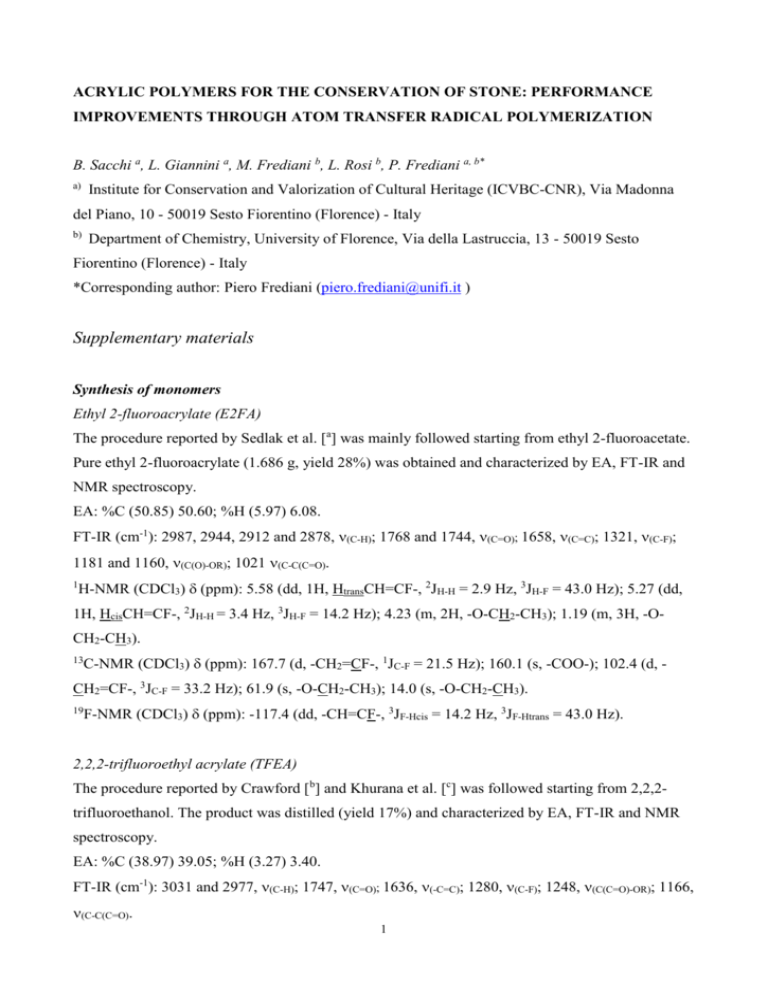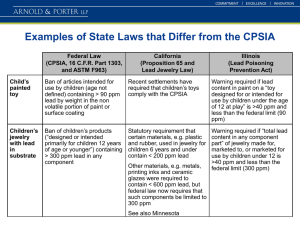3 Khurana JK, Sahoo PK, Maikap GC Sonochemical Esterification of
advertisement

ACRYLIC POLYMERS FOR THE CONSERVATION OF STONE: PERFORMANCE IMPROVEMENTS THROUGH ATOM TRANSFER RADICAL POLYMERIZATION B. Sacchi a, L. Giannini a, M. Frediani b, L. Rosi b, P. Frediani a, b* a) Institute for Conservation and Valorization of Cultural Heritage (ICVBC-CNR), Via Madonna del Piano, 10 - 50019 Sesto Fiorentino (Florence) - Italy b) Department of Chemistry, University of Florence, Via della Lastruccia, 13 - 50019 Sesto Fiorentino (Florence) - Italy *Corresponding author: Piero Frediani (piero.frediani@unifi.it ) Supplementary materials Synthesis of monomers Ethyl 2-fluoroacrylate (E2FA) The procedure reported by Sedlak et al. [a] was mainly followed starting from ethyl 2-fluoroacetate. Pure ethyl 2-fluoroacrylate (1.686 g, yield 28%) was obtained and characterized by EA, FT-IR and NMR spectroscopy. EA: %C (50.85) 50.60; %H (5.97) 6.08. FT-IR (cm-1): 2987, 2944, 2912 and 2878,(C-H); 1768 and 1744, (C=O); 1658, (C=C); 1321,(C-F); 1181 and 1160, (C(O)-OR); 1021 (C-C(C=O). 1 H-NMR (CDCl3) (ppm): 5.58 (dd, 1H, HtransCH=CF-, 2JH-H = 2.9 Hz, 3JH-F = 43.0 Hz); 5.27 (dd, 1H, HcisCH=CF-, 2JH-H = 3.4 Hz, 3JH-F = 14.2 Hz); 4.23 (m, 2H, -O-CH2-CH3); 1.19 (m, 3H, -OCH2-CH3). C-NMR (CDCl3) (ppm): 167.7 (d, -CH2=CF-, 1JC-F = 21.5 Hz); 160.1 (s, -COO-); 102.4 (d, - 13 CH2=CF-, 3JC-F = 33.2 Hz); 61.9 (s, -O-CH2-CH3); 14.0 (s, -O-CH2-CH3). 19 F-NMR (CDCl3) (ppm): -117.4 (dd, -CH=CF-, 3JF-Hcis = 14.2 Hz, 3JF-Htrans = 43.0 Hz). 2,2,2-trifluoroethyl acrylate (TFEA) The procedure reported by Crawford [b] and Khurana et al. [c] was followed starting from 2,2,2trifluoroethanol. The product was distilled (yield 17%) and characterized by EA, FT-IR and NMR spectroscopy. EA: %C (38.97) 39.05; %H (3.27) 3.40. FT-IR (cm-1): 3031 and 2977,(C-H); 1747, (C=O); 1636, (-C=C); 1280,(C-F); 1248, (C(C=O)-OR); 1166, (C-C(C=O). 1 1 H-NMR (CDCl3) (ppm): 6.55 (dd, 1H, HtransCH=CH-, 2JH-H = 1.2 Hz, 3JH-H = 17.3 Hz); 6.13 (dd, 1H, CH2=CH-, 3JH-Htrans = 17.3 Hz, 3JH-Hcis = 10.5 Hz); 5.95 (dd, 1H, HcisCH=CH-, 2JH-H = 1.2 Hz, 3 JH-H = 10.5 Hz); 4.49 (q, 2H, -OCH2CF3, 3JH-F = 9.0 Hz). C-NMR (CDCl3) (ppm): 164.6 (s, -C=O-); 133.4 (s, CH2=CH-); 126.8 (s, CH2=CH-); 121.4 (q, - 13 O-CH2-CF3, 1JC-F = 32.2 Hz); 77.6 (q, -O-CH2-CF3, 2JC-F = 36.8 Hz). 19 F-NMR (CDCl3) (ppm): -74.1 (t, -CF3, 3JF-H = 9.0 Hz). Synthesis of polymers Poly(ethyl methacrylate-co-methyl acrylate) 70/30 [PB72] The Rohm & Haas product was employed as reference material, used as supplied, without any further purification. Poly(methyl acrylate), classical radical polymerization [PMA-AIBN] The polymer was prepared as reference material through a standard radical polymerization using AIBN as radical initiator. The polymer was characterized by SEC (Table 1), DSC (Table 1), EA, FT-IR and NMR spectroscopy. EA: %C (55.81) 56.04; %H (7.03) 7.25. FT-IR (cm-1): 2954,(C-H); 1732, (C=O); 1264, 1197 and 1165, (C(C=O)-OR). 1 H-NMR (CDCl3) (ppm): 2.40-2.20 (m 1H, -CH-); 2.00-1.30 (m, 2H, -CH2-), 3.6 (s, 3H, -OCH3). Poly(ethyl 2-fluoroacrylate), classical radical polymerization [PE2FA] It was obtained using AIBN as radical initiator. The polymer was characterized by GPC (Table 1), DSC (Table 1), EA, FT-IR and NMR spectroscopy. EA: %C (50.85) 51.05; %H (5.98) 6.05. FT-IR (cm-1): 2985, 2941 and 2908,(C-H); 1766 and 1743, (C=O); 1348,(C-F); 1265, 1175 and 1153, (C(C=O)-OR); 1020 (C-C(C=O). 1 H-NMR (CDCl3) (ppm): 4.28 (m, 2H, -OCH2); 2.77-1.56 (m, 2H, -CH2); 1.42 (m, 3H, -OCH2- CH3). C-NMR (CDCl3) (ppm): 174.7 (s, -C=O); 77.5-77.1-76.7 (d, -CF, JC-F = 20.2 Hz); 60.9 (-O- 13 CH2); 41.6 (-CH2-CF); 14.5-14.4 (CH3). 19 F-NMR (CDCl3) (ppm): -166.8 (m, -CF-). Poly(2,2,2-trifluoroethyl acrylate) classical radical polymerization [PTFEA] 2 It was synthesized using AIBN as radical initiator. The polymer was characterized by GPC (Table 1), DSC (Table 1), EA, FT-IR and NMR spectroscopy. EA: %C (38.94) 39.10; %H (3.36) 3.50. FT-IR (cm-1): 2975,(C-H); 1756, (C=O); 1383,(C-F); 1282 and 1168, (C(C=O)-OR). 1 H-NMR (CDCl3) (ppm): 3.94-2.64 (m, 1H, -CH-), 2.37-1.45 (m, 2H, -CH2-); 4.68-4.40 (m, 2H, - OCH2-CF3). C-NMR (CDCl3) (ppm): 172.9 (-C=O-), 124.9 (q, -CF3, 1JC-F: 20.1); 60.9 (m, -O-CH2-CF3); 45- 13 42 (m, -CH-); 41.0 (m, -CH2-CH-CO2-). 19 F-NMR (CDCl3) (ppm): -74.4 (t, -CH2-CF3, 3JFH = 9.0 Hz)). Poly(methyl acrylate), ATRP polymerization [PMA(n)] The procedure reported by Wang et al. [d] for the synthesis of polystyrene and poly(alkyl methacrylates) was followed. Syntheses were performed, in different conditions as reported in Table 1.Crude polymer was dissolved in chloroform (3 ml) and precipitated by addition to a n-hexane solution (15 ml). A further purification was performed: a 2% chloroform solution of the polymer was eluted on acid activated alumina column, using chloroform or chloroform/acetone as eluent. The solution was collected, the solvent removed under vacuum and the polymer characterized by SEC (Table 1), DSC (Table 1), EA, FT-IR and NMR spectroscopy. PMA(1) : EA: %C (55.78) 56.01; %H (7.01) 7.25. FT-IR (cm-1): 2954,(C-H); 1742, (C=O); 1265, 1197 and 1166, (C(C=O)-OR). 1 H-NMR (CDCl3) (ppm): 3.60 (s, 3H, -OCH3); 2.20 (m, 1H, -CH-); 2.00-1.20 (m, 2H, -CH2-). C-NMR (CDCl3) (ppm): 174.7 (s, C=O-); 51.6 (s, -OCH3); 45.0-40.0 (m, -CH-); 37-30 (m, - 13 CH2-). PMA(2) : EA: %C (55.78) 56.10; %H (7.01) 7.05. FT-IR (cm-1): 2954,(C-H); 1738 (C=O); 1265, 1242, 1197 and 1165, (C(C=O)-OR); 1 H-NMR (CDCl3) (ppm): 3.60 (s, 3H, -OCH3); 2.20 (m, 1H, -CH-); 2.00-1.00 (m, 2H, -CH2-); C-NMR (CDCl3) (ppm): 174.7 (s, C=O-); 51.5 (s, -OCH3); 45.0-40.0 (m, -CH-); 40-30 (m, - 13 CH2-). PMA(3) : EA: %C (55.78) 56.05; %H (7.01) 7.15. FT-IR (cm-1): 2954,(C-H); 1737, (C=O); 1263, 1242, 1197 and 1165, (C(C=O)-OR) 1 H-NMR (CDCl3) (ppm): 3.60 (s, 3H, -OCH3); 2.20 (m, 1H, -CH-); 2.00-1.10 (m, 2H, -CH2-) 3 C-NMR (CDCl3) (ppm): 174.7 (s, -C=O-); 51.6 (s, -OCH3); 45.0-40.0 (m, -CH-); 40-30 (m, - 13 CH2-). PMA(4) : EA: %C (55.78) 55.99; %H (7.01) 7.05. FT-IR (cm-1): 2954,(C-H); 1737, (C=O); 1263, 1198 and 1166, (C(C=O)-OR). 1 H-NMR (CDCl3) (ppm): 3.60 (s, 3H, -OCH3); 2.20 (m, 1H, -CH-); 2.00-1.00 (m, 2H, -CH2-). C-NMR (CDCl3) (ppm): 174.7 (s, -C=O-); 51.6 (s, -OCH3); 45.0-40.0 (m, -CH-); 37.0-30.0 (m, 13 -CH2-). Poly(methyl acrylate-co-perfluoropolyether), ATRP polymerization [PMA-F(n)] Syntheses of PMA via ATRP were performed following the procedure reported by Wang, using the reaction conditions reported in Table 1 and the isobutyl ester of FluoroLink, as initiator. The polymer was dissolved in chloroform (3 ml) and precipitated by addition to a n-hexane solution (15 ml), and then washed with an aqueous HCl solution (pH=3). A further purification was performed: a 2% chloroform solution of the polymer was eluted on acid activated alumina column, using chloroform or chloroform/acetone as eluent. The solution was collected and solvent removed under vacuum. The polymer was characterized by SEC (Table 1), DSC (Table 1), FT-IR and NMR spectroscopy. PMA-F(1): FT-IR (cm-1): 2954,(C-H); 1784 and 1737, (C=O); 1241,(C-F); 1265, 1197 and 1165, (C(C=O)-OR). 1 H-NMR (CDCl3) (ppm): 3.7 (s, 3H, -OCH3); 2.4 (s, 1H, -CH-); 2.1-1.2 (m, 2H, -CH2-); furthermore the signals of the FLE moiety were present at (ppm): 4.1 (d, 2H, -CH2-, JH-H = 6.4 Hz); 2.1-1.9 (m, 1H, -CH-, JH-H = 6.5 Hz, JH-H = 6.4 Hz); 1.0 (d, 6H, -CH3, JH-H = 6.5 Hz). C-NMR (ppm): 174.6 (s, C=O-), 51.4 (s, -OCH3); 45.0-37.0 (m, -CH-); 37.0-30.0 (m, -CH2-); 13 furthermore weak signals of the FLE moiety were present. 19 F-NMR (CDCl3) (ppm): -76.2 (-Acr-C(CF3)2-O-Rf), -77.3 (-Acr-C(CF3)2-O-Rf), -80.1 (-O-CF2- CF(CF3)-O-), -83.8 (-O-CF2-CF(CF3)-O-), -86.5 (-CF2-COOR-), -145.2 (-O-CF2-CF(CF3)-O-). PMA-F(2): FT-IR (cm-1): 2954,(C-H); 1782 and 1736, (C=O); 1238,(C-F); 1263, 1197 and 1164, (C(C=O)-OR). 1 H-NMR (CDCl3) (ppm): 3.7 (s, 3H, -OCH3); 2.3 (s, 1H, -CH-); 2.1-0.9 (m, 2H, -CH2-); furthermore the signals of the FLE moiety were present at (ppm): 4.1 (d, 2H, -CH2-, JH-H = 6.4 Hz); 2.1-1.9 (m, 1H, -CH-, JH-H = 6.5 Hz, JH-H = 6.4 Hz); 1.0 (d, 6H, -CH3, JH-H = 6.5 Hz). C-NMR (CDCl3) (ppm): 174.7 (s, C=O-), 51.3 (s, -OCH3), 45.0-37.0 (m, -CH-); 37.0-30.0 (m, 13 -CH2-); furthermore weak signals of the FLE moiety were present. 4 19 F-NMR (CDCl3) (ppm): -75.4 (-Acr-CF2-CF(CF3)-O-Rf), -78.6 (-Acr-CF2-CF(CF3)-O-Rf), - 80.1 (-O-CF2-CF(CF3)-O-), -83.9 (-O-CF2-CF(CF3)-O-), -86.4 (-CF2-COOR), -141.0 ((-Acr-CF2CF(CF3)-O-Rf), -145.6 (-O-CF2-CF(CF3)-O-). 5 Figure 1SM: FT-IR spectra of PMA-F(1) collected after 0 ( – ), 96 ( – ), 250 ( – ), 500 ( – ), 750 ( – ) and 1000 h ( – ) of UV irradiation 6 Figure 2SM: FT-IR spectra of PMA-AIBN collected after 0 ( – ), 72 ( – ), 250 ( – ), 500 ( – ), 750 ( – ) and 1000 h ( – ) of UV irradiation 7 Figure 3SM: FT-IR spectra of PE2FA collected after 0 ( – ), 68 ( – ), 250 ( – ), 500 ( – ), 750 ( – ) and 1000 h ( – ) of UV irradiation 8 Figure 4SM: FT-IR spectra of PTFEA collected after 0 ( – ), 68 ( – ), 250 ( – ), 500 ( – ), 750 ( – ) and 1000 h ( – ) of UV irradiation References_SM a) Sedlak J.K. α-Fluoroacrylates, US Patent 3075002, 1963. b) Sedlak J.K., Matsuda K. αFluoroacrylates, US Patent 3,262,968, 1966. a b Crawford J.W.C. Properties of some higher polymethacrylic esters, J. Soc. Chem. Ind., Trans. Comm., 68, 1949, 201-208. c Khurana J.K., Sahoo P.K., Maikap G.C. Sonochemical Esterification of Carboxylic Acids in Presence of Sulphuric Acid, Synth. Comm., 1990, 20, 2267-2271 d Wang J.S., Matyjaszewski K. Controlled "Living" Radical Polymerization. Halogen Atom Transfer Radical Polymerization Promoted by a Cu(I)/Cu(II) Redox Process, Macromolecules, 1995, 28, 7901-7910 9






